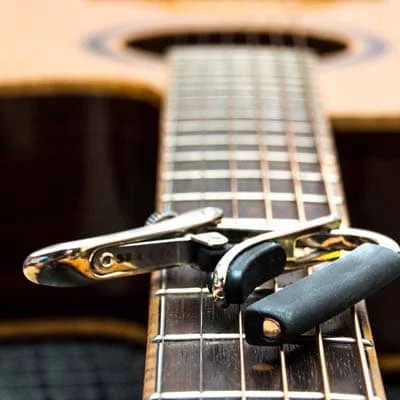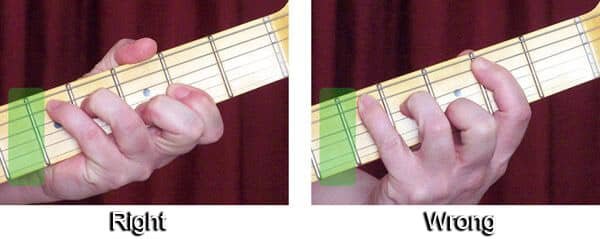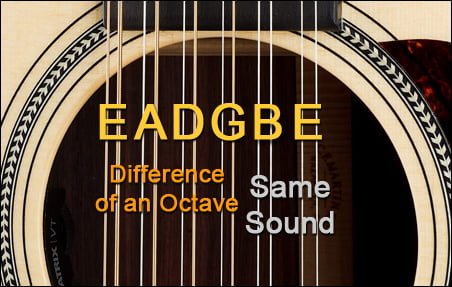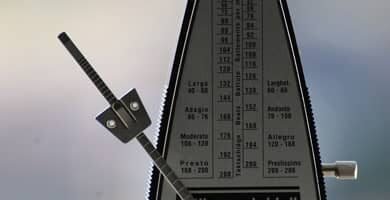
How to TUNE the GUITAR, to Get a More Stable and Lasting Tuning. Learn to Tune a 6, 7, 8, and 12 String Guitar.
Among the most basic and essential when starting to learn to play, is knowing how to tune the guitar. Since it is an instrument that goes out of tune very easily, especially when placing new strings, or due to the continued use of string bending.
If the instrument is out of tune, even if we put our fingers where they should, it won’t sound right. Especially in the case of a heavily distorted electric guitar, good tuning is vital for an acceptable sound.
How to Tune a Guitar: Standard Tuning
The notes that we must achieve by playing the open strings (without pressing any fret) in a standard or concert tuning are: E – A – D – G – B – E (from the thickest string to the thinnest). Although we can also use Alternative Tunings to the standard one.

How to Tune a Guitar Properly
A very common mistake, especially by beginners, is to loosen the string to reach the correct note, when the note indicated by our tuner is higher than the precise tone.
But when you do this, the string may not slide correctly through the nut and guides, creating different tension forces in the string. With which the string is very likely to quickly go out of tune again.
For this reason it is always better in the event that the string is overtensioned, to loosen the string a little below its correct tone, and then tighten it again until reaching the appropriate note.
How to Maintain Stable Tuning
One of the main and most common problems in tuning stability arises when we put new strings on the guitar. Since the strings that have never been subjected to tension are very prone to quickly losing tension stability.
Stretch the Strings
To solve this to a large extent, what we must do is subject the strings to an intensive tensioning process, so that they reach a certain tuning stability, as soon as possible.
So once one of the strings is in tune, we tighten it a little by hand, or by performing a bending. When checking again with the tuner, we will see that the string has gone out of tune again, and we tighten the string again until we reach the appropriate note.

To give the string time to stabilize a bit, we move on to the next strings. We will repeat this same process over and over again until the strings give up, and reach a certain stability.
We must be a little careful when tightening, especially the first two strings, since we can break them if we forget our common sense.
How to Change Guitar Strings
Something to keep in mind when enjoying good tuning stability is knowing how to place the strings correctly on our guitar. You can visit the page “How to Change Strings on the Guitar” to learn how to install them correctly.
The tuning can also be inaccurate or short-lived, if we keep the same set of strings on our guitar for too long, or if they are in poor condition.
Should you tune your guitar with the capo on?
Another factor that can affect the correct tuning of the guitar is the placement of a capo. Many think that by placing a capo on a well-tuned guitar, it will remain perfectly in tune after placing a capo on a certain fret.

But in reality this is very unlikely, since this tuning can be affected, even depending on the tension applied by the capo.
So after placing a capo, we must always touch up the tuning, if we want to have the most optimized sound possible.
Our way of playing can also affect the tuning of the guitar. Since if we press the strings excessively against the frets, the string will deform, causing the note to go out of tune. Something that can be really palpable when we place a chord.
We must also be careful to keep the strings parallel to each other, after placing a chord. A very common mistake when we place our first chords, or when we use chords that we do not normally use. It is not necessary to explain the reason for this problem, since the more we stretch the strings, the more out of tune the chord will sound.

Finally, I recommend the Guitar Tuner Online of Electric Guitar Manual, if you need an audio sample of all the guitars mentioned above, and some more.
With this tuner you can tune your guitar and other string instruments, but it also shows you the audio of each string of countless types of guitars and other instruments such as bass or ukulele. You have a link below.
7 and 8 String Guitar Tuning
The standard tuning of a 7-string guitar would be identical to that of a six-string guitar, but adding a B note for its seventh string. Consequently, it would look like this starting from the heavy string:
B – E – A – D – G – B – E
In the case of 8-string guitars, the standard tuning would be identical to the tuning of a 7-string guitar, with the addition of an F# for the eighth, or heavy string. The notes are distributed as follows, starting from the heavy string:
F♯ – B – E – A – D – G – B – E
Although some guitarists decide to tune the 8th string in E. In this case the guitar would have three E notes in different octaves, obtaining a very complete sound.
E – B – E – A – D – G – B – E
How to Tune a 12 String Guitar
En el caso de las guitarras de 12 cuerdas, la afinación estándar sería idéntica a una guitarra de 6 cuerdas, con la diferencia de que se trataría de 6 parejas de cuerdas.
In the case of 12-string guitars, the standard tuning would be identical to a 6-string guitar, with the difference that there would be 6 pairs of strings.

From the third string to the sixth string pair, there is an octave difference between the strings that make up the pair. And for the first and second pair of strings, the tuning would be identical on both strings that make up the pair.


